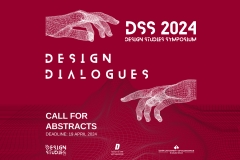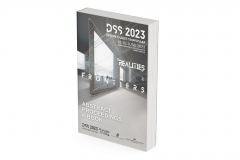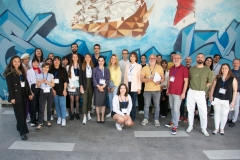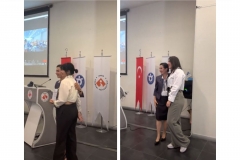
GRADUATE SCHOOL
Design Studies (With Thesis)
FFD 513 | Course Introduction and Application Information
| Course Name |
Discourses of Design and Architecture in the 20th Century
|
|
Code
|
Semester
|
Theory
(hour/week) |
Application/Lab
(hour/week) |
Local Credits
|
ECTS
|
|
FFD 513
|
Fall/Spring
|
3
|
0
|
3
|
0
|
| Prerequisites |
None
|
|||||
| Course Language |
English
|
|||||
| Course Type |
Elective
|
|||||
| Course Level |
Second Cycle
|
|||||
| Mode of Delivery | - | |||||
| Teaching Methods and Techniques of the Course | DiscussionGroup WorkLecture / Presentation | |||||
| Course Coordinator | - | |||||
| Course Lecturer(s) | ||||||
| Assistant(s) | - | |||||
| Course Objectives | This course aims to introduce the design discourses of 20th century on the background of historical developments. Within the scope of this course, spaces and buildings that are the main cases of understanding the spirit of this era are concentrated on as an introduction to the design discourses of 20th century. |
| Learning Outcomes |
The students who succeeded in this course;
|
| Course Description | The course focuses on the design discourses of 20th century modern world to understand the bases of today's contemporary approaches. Almost each topic is discussed through the center periphery theory so as to see the continuities and discontinuities between the design approaches and historical periods not only in the center but also in the periphery. |
|
|
Core Courses | |
| Major Area Courses | ||
| Supportive Courses | ||
| Media and Management Skills Courses | ||
| Transferable Skill Courses |
WEEKLY SUBJECTS AND RELATED PREPARATION STUDIES
| Week | Subjects | Related Preparation |
| 1 | Introduction | |
| 2 | Manifestoes of a New Era: Adolf Loos and Ornament is Crime | Frampton, K., Modern Architecture A Critical History, Thames & Hudson, 90-95, ISBN: 0-500-20257-5 |
| 3 | Futurism: Antonio Saint'Alia | Frampton, K., Modern Architecture A Critical History, Thames & Hudson, 90-95, ISBN: 0-500-20257-5 |
| 4 | Russian Constructivism: Tatlin | Frampton, K., Modern Architecture A Critical History, Thames & Hudson, 90-95, ISBN: 0-500-20257-5 |
| 5 | Modern Space: Le Corbusier and Five Principles | Frampton, K., Modern Architecture A Critical History, Thames & Hudson, 90-95, ISBN: 0-500-20257-5 |
| 6 | Bauhaus: Walter Gropius and Modern Design Education Universal Style: Mies van der Rohe and Less is More | Frampton, K., Modern Architecture A Critical History, Thames & Hudson, 90-95, ISBN: 0-500-20257-5 |
| 7 | Student Presentations I | |
| 8 | Student Presentations I | |
| 9 | Northern Pioneers: Scharoun, Aalto, Erskine and seeking for the Democratic Space | Frampton, K., Modern Architecture A Critical History, Thames & Hudson, 90-95, ISBN: 0-500-20257-5 |
| 10 | Modern of the Periphery: Sedad Hakkı Eldem combining Tradition and Modern | |
| 11 | Japanese Metabolists: Kurokawa and Maki | Frampton, K., Modern Architecture A Critical History, Thames & Hudson, 90-95, ISBN: 0-500-20257-5 |
| 12 | Postmodernism: Jencks, Moore, Stirling, Krier and Less is Bore | Frampton, K., Modern Architecture A Critical History, Thames & Hudson, 90-95, ISBN: 0-500-20257-5 |
| 13 | Deconstructivism: Gehry and Eisenman Comtemporary Approaches: Koolhaas, Libeskind, Hadid, Big and Yes is More | Frampton, K., Modern Architecture A Critical History, Thames & Hudson, 90-95, ISBN: 0-500-20257-5 |
| 14 | Student Presentations II | |
| 15 | Semester review | |
| 16 | Semester review |
| Course Notes/Textbooks |
|
| Suggested Readings/Materials |
|
EVALUATION SYSTEM
| Semester Activities | Number | Weigthing |
| Participation |
1
|
10
|
| Laboratory / Application | ||
| Field Work | ||
| Quizzes / Studio Critiques | ||
| Portfolio | ||
| Homework / Assignments |
1
|
30
|
| Presentation / Jury |
2
|
60
|
| Project | ||
| Seminar / Workshop | ||
| Oral Exams | ||
| Midterm | ||
| Final Exam | ||
| Total |
| Weighting of Semester Activities on the Final Grade |
4
|
100
|
| Weighting of End-of-Semester Activities on the Final Grade | ||
| Total |
ECTS / WORKLOAD TABLE
| Semester Activities | Number | Duration (Hours) | Workload |
|---|---|---|---|
| Theoretical Course Hours (Including exam week: 16 x total hours) |
16
|
3
|
48
|
| Laboratory / Application Hours (Including exam week: '.16.' x total hours) |
16
|
0
|
|
| Study Hours Out of Class |
10
|
8
|
80
|
| Field Work |
0
|
||
| Quizzes / Studio Critiques |
0
|
||
| Portfolio |
0
|
||
| Homework / Assignments |
6
|
4
|
24
|
| Presentation / Jury |
2
|
29
|
58
|
| Project |
0
|
||
| Seminar / Workshop |
0
|
||
| Oral Exam |
0
|
||
| Midterms |
0
|
||
| Final Exam |
0
|
||
| Total |
210
|
COURSE LEARNING OUTCOMES AND PROGRAM QUALIFICATIONS RELATIONSHIP
|
#
|
Program Competencies/Outcomes |
* Contribution Level
|
||||
|
1
|
2
|
3
|
4
|
5
|
||
| 1 | to be able to expand the practical knowledge gained in undergraduate programs with theoretical field of design research, |
|||||
| 2 | to be able to examine, interpret data and assess concepts and ideas with research methods of design theory and social sciences, |
|||||
| 3 | to be able to identify problems of design disciplines in times of global / environmental crisis and to be able to develop possible solutions for design practitioners, |
|||||
| 4 | to be able to expand knowledge on the history of material culture as it relates to design practices of the past, |
|||||
| 5 | to be able to promote research on local practices of everyday life and assess the outcome to implement design solutions, |
|||||
| 6 | to be able to facilitate interactions in between varied design disciplines and to promote collaborative work to solve complex problems, |
|||||
| 7 | to be able to process outcome of design research to be applied in design education, |
|||||
| 8 | to be able to instigate research on the new tools, technologies and materials of production in order to accelerate changes in design practices, |
|||||
| 9 | to be able to develop an ethical approach towards design professions in order to install social and environmental responsibilities, |
|||||
| 10 | to be able to use a foreign language for both chasing the scientific publication and developing proper communication with colleagues from other countries, in written and verbal ways. |
|||||
| 11 | to be able to use computer programs needed in the field design as well as information and communication technologies in advanced levels (“European Computer Driving Licence”, Advanced Level”). |
|||||
*1 Lowest, 2 Low, 3 Average, 4 High, 5 Highest
NEWS |ALL NEWS

DSS 2024 CALL FOR PAPERS | THEME: DESIGN DIALOGUES
DSS 2024 CALL FOR PAPERS THEME: DESIGN DIALOGUES The Design Studies Graduate Program and the Faculty of Fine Arts and Design at the Izmir

Abstract Proceedings e-Book for the Design Studies Symposium 2023 is available now!
The Design Studies Symposium 2023 (DSS 2023), organized in collaboration with İzmir University of Economics Graduate School Design Studies Master's and PhD

Design Studies Symposium 2023: Realities & Frontiers
The Design Studies Symposium 2023 (DSS 2023) organized by the IEU Graduate School Design Studies programs was held on 1-2 June, at

The Best Paper Award at the Design Studies Symposium 2023: Realities & Frontiers
The voting for the best presentation award at the Design Studies Symposium 2023 (DSS 2023) organized by the IEU Graduate School Design




